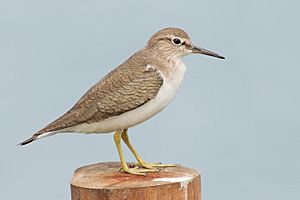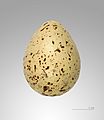Common sandpiper facts for kids
Quick facts for kids Common sandpiper |
|
|---|---|
 |
|
| An adult common sandpiper in Laem Pak Bia, Thailand | |
| Conservation status | |
| Scientific classification | |
 |
|
| Where common sandpipers live: Breeding areas Non-breeding areas Passage areas Possibly still found (non-breeding) Possibly still found (passage) | |
| Synonyms | |
|
Tringa hypoleucos Linnaeus, 1758 |
The common sandpiper (Actitis hypoleucos) is a small, active bird that belongs to the sandpiper family. It's known for its unique way of moving and its long journeys. These birds are famous for being migratory, which means they travel long distances between their breeding and wintering homes each year.
During the warmer summer months, you can find common sandpipers all across Europe and Asia. When winter arrives, they fly south to spend their time in warmer places like the Mediterranean region and North Africa. Some even travel as far as Australia!
Contents
What Does It Look Like?
The common sandpiper is a small bird, usually about 18 to 20 centimeters (7 to 8 inches) long. It has a brownish-grey back and a bright white belly. A key feature is the white stripe that goes above its eye.
Unique Features
You might notice a distinct white patch that extends from its chest up onto its shoulder. This patch separates the brown on its back from the white on its belly. Its legs are short and yellowish-grey, and its bill is medium-sized and dark.
Where Do They Live?
Common sandpipers prefer to live near water. You'll often find them along the banks of rivers, lakes, and streams. They also like rocky or sandy coastlines.
Habitat Choices
During the breeding season, they choose areas with clear, flowing water and some vegetation nearby. In winter, they might be seen in coastal areas, estuaries, and even rice paddies.
What Do They Eat?
Common sandpipers are expert foragers. They mostly eat small insects and other tiny creatures they find in the mud or shallow water.
Hunting Style
They use their bills to probe into the mud or pick insects off the surface of the water. Their diet includes beetles, flies, worms, and sometimes small crustaceans or fish.
Amazing Migrations
These birds are incredible travelers. Every year, they fly thousands of kilometers between their summer breeding grounds and their winter homes.
Journey Details
Common sandpipers that breed in northern Europe might fly all the way to Africa for the winter. This long journey helps them find food and suitable weather year-round.
How Do They Behave?
One of the most interesting things about the common sandpiper is its unique way of moving. It has a constant, bobbing motion of its tail and rear body.
Bobbing Motion
This bobbing is often called "teetering" or "tail-wagging." Scientists aren't entirely sure why they do it, but it might help them balance or signal to other birds. They are also quite shy and will often fly away quickly if disturbed.
Breeding and Young
Common sandpipers usually breed in the spring and early summer. The female lays her eggs in a shallow nest on the ground, often hidden among plants near water.
Raising Chicks
Both parents help to incubate the eggs and care for the chicks once they hatch. The young birds are able to leave the nest and find food for themselves shortly after hatching.
Conservation Status
The common sandpiper is listed as a species of "Least Concern" by the International Union for Conservation of Nature (IUCN). This means their populations are currently stable and not considered to be at high risk.
Protecting Their Homes
However, like many birds, they can be affected by habitat loss and pollution. Protecting their wetland habitats is important to ensure these fascinating birds continue to thrive.
Images for kids
See also
In Spanish: Andarríos chico para niños





